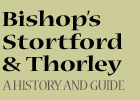|

This area was the very heart of the medieval town and, as such, formed the north-western part of its large market place. The street layout remains virtually unchanged, but this narrow thoroughfare linking Bridge Street with Market Square was known then as Chandlers Row the name derived from the many chandlers, or candle-makers, who traded here. Chandlers were among the busiest market traders, but the candle-making process certainly wasn't a pleasant one. Made of tallow (the white solid fat of cattle and sheep), its putrifying smell while being melted down and then left to solidify around a cotton wick must have turned even the strongest stomachs.
*Candles were used primarily for illuminating people's homes. It's been estimated that great houses could use up to 100lb of tallow in a single winter's night. The less well-off probably went to bed early.
Local legend has it that Palmers Lane is named after a tallow chandler named William Palmer. No doubt this is true, but the earliest reference I can find to Mr Palmer is in an 1839 trade directory where his address is given as Bridge Street. Palmers Lane did exist at that time, so it could be that his business was housed in the property at the corner of the lane where it joins Bridge Street.
Three businesses that were present in Palmers Lane in 1839 were: Richard Searle, Tailor and clothes dealer; John Hughan, Tea Dealer; and Thomas Clark, Patten Maker. The workshops these people used were probably housed in the two 17th century buildings that still stand, one of which (No 9) retains its original timber cladding, pierced at one end by a small arched window. Past evidence found within this building also suggests it was once used by a Cordwainer as a workshop for shoemakers.
The building alongside it currently owned by Zelley’s, established in the town since 1910 is timber-framed with a brick built Georgian frontage. This property has been host to numerous shops and businesses over the years, but perhaps the most unusual occupier in the 1970s and early 80s was Cramphorns Garden Centre. From these premises were sold mostly pets and garden equipment, with plants and shrubs available from the shop’s small yard in Devoils Lane.
The building at the top of Palmers Lane that faces Potter Street was a public house in the late 19th century, owned by McMullen’s brewery. But unlike all of the other pubs in Stortford it only opened for business on a Thursday market day. At that time the property was just two storeys high but has since been radically altered by the addition of a third floor and attic room. MORE PICTURES
|
|
Opposite the Corn Exchange, between Market Square and the crossroads, an early 19th century building houses two shops both rare and nostalgic reminders of life before supermarkets entered our daily lives.
The first is Dorringtons the bakers a long established name in Bishop’s Stortford and next to it a butchers shop, one of only two currently trading in the town. An entrance between the two leads to a small restaurant above the shops.
Between 1750 and 1907 the corner of Market Square and Bridge was occupied by the Bell Inn originally built as a timber-frame and plaster structure but later rebuilt of brick. When the inn closed, the premises became first a barbers shop and then a branch of the *National Provincial Bank. This was demolished in November 1936 to be replaced by the large and rather elegant building that stands today. The same bank occupied the new building before moving to its present position in North Street, and in the 1940s it was home to Price Bailey.
*The National Provincial Bank eventually amalgamated with National Westminster Bank, which was later renamed NatWest. It is the oldest established bank in the town (See Guide 6 NatWest Bank). MORE PICTURES
|




